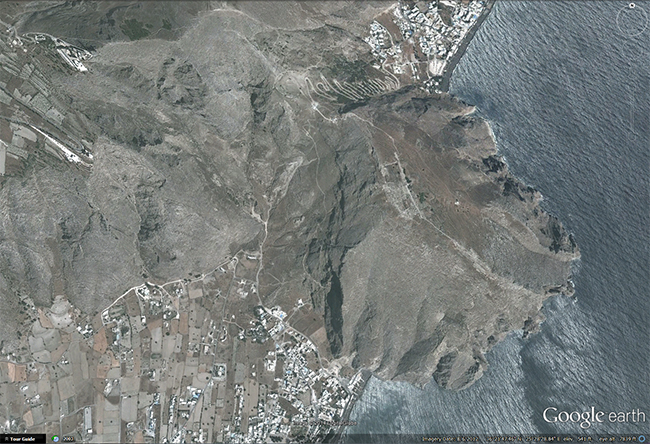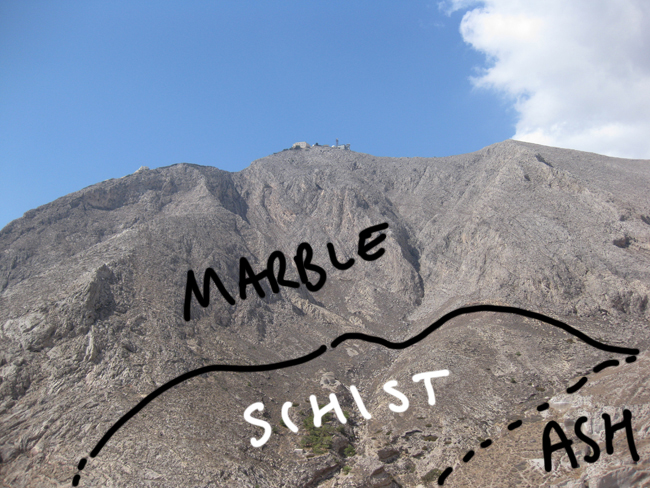9 October 2014
In search of Santorini’s blueschist, part 1: into the Valley of the Shadow of Ash
Posted by Callan Bentley
One afternoon during my stay in Santorini last month, I went for a solo geology hike. I left our hotel in the beach town of Perissa, and walked north toward the prominent mountain where I had reason to suspect I would find marble and blueschist – the subducted remains of the Tethys Ocean basin. I headed towards a prominent cliff which had a karsty-looking hollow in which prominently sat a white church of some sort.

In the next shot, you can see the church at the upper right, but the focus shifts to the prominent geologic contact to the west (left) of it.

This is the contact, I inferred between marble (which weathers out more prominently in this exceptionally arid environment), and an underlying body of schist, which would be a valley-former:

For reasons I’ll reveal later, I think this contact may be a fault.

Here’s a view directly northward into the valley west of the church-cliff mountain.

There’s a new geologic unit in this shot. In the middle of the valley is a light-colored, stratified, easily weathered rock unit. From a distance, I inferred this to be volcanic ash from the eruption of Santorini’s volcano. Later, I confirmed this by collecting several large blobs of pumice from this unit.

So this is neat – in the most central hollow of this schisty valley, there’s a nice horizontally-layered ash deposit. That means the valley already existed at the time of the eruption, otherwise there would be no topographic basin to catch and hold this ash.
Here’s a Google Earth view of the valley, north of the beach town of Perissa:

Now for some annotations, to show the trace of the contact between the marble (M) and the schist (S), and the ash deposit (A) in the deepest part of the valley:

I also indicated where the towns are, and the location of that white church in the shadow of the most prominent cliff.
Looking across the valley to the west:


A final perspective, this looking obliquely northwest into the valley:

Note the little hollows (“caves”) cut into the lowermost outcrop of the ash.

Okay, so now, can we finally examine the schist itself, in search of the blue variety?
Patience, grasshopper…. Next week.


 Callan Bentley is Associate Professor of Geology at Piedmont Virginia Community College in Charlottesville, Virginia. He is a Fellow of the Geological Society of America. For his work on this blog, the National Association of Geoscience Teachers recognized him with the James Shea Award. He has also won the Outstanding Faculty Award from the State Council on Higher Education in Virginia, and the Biggs Award for Excellence in Geoscience Teaching from the Geoscience Education Division of the Geological Society of America. In previous years, Callan served as a contributing editor at EARTH magazine, President of the Geological Society of Washington and President the Geo2YC division of NAGT.
Callan Bentley is Associate Professor of Geology at Piedmont Virginia Community College in Charlottesville, Virginia. He is a Fellow of the Geological Society of America. For his work on this blog, the National Association of Geoscience Teachers recognized him with the James Shea Award. He has also won the Outstanding Faculty Award from the State Council on Higher Education in Virginia, and the Biggs Award for Excellence in Geoscience Teaching from the Geoscience Education Division of the Geological Society of America. In previous years, Callan served as a contributing editor at EARTH magazine, President of the Geological Society of Washington and President the Geo2YC division of NAGT.